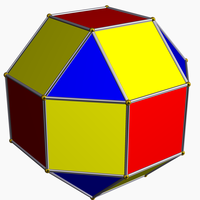Small rhombicuboctahedron
| Small rhombicuboctahedron | |
|---|---|
 | |
| Rank | 3 |
| Type | Uniform |
| Notation | |
| Bowers style acronym | Sirco |
| Coxeter diagram | x4o3x ( |
| Conway notation | eC |
| Stewart notation | E4 |
| Elements | |
| Faces | |
| Edges | 24+24 |
| Vertices | 24 |
| Vertex figure | Isosceles trapezoid, edge lengths 1, √2, √2, √2  |
| Measures (edge length 1) | |
| Circumradius | |
| Volume | |
| Dihedral angles | 4–3: |
| 4–4: 135° | |
| Central density | 1 |
| Number of external pieces | 26 |
| Level of complexity | 4 |
| Related polytopes | |
| Army | Sirco |
| Regiment | Sirco |
| Dual | Deltoidal icositetrahedron |
| Conjugate | Quasirhombicuboctahedron |
| Abstract & topological properties | |
| Flag count | 192 |
| Euler characteristic | 2 |
| Surface | Sphere |
| Orientable | Yes |
| Genus | 0 |
| Properties | |
| Symmetry | B3, order 48 |
| Flag orbits | 4 |
| Convex | Yes |
| Nature | Tame |
The small rhombicuboctahedron, also commonly known as simply the rhombicuboctahedron, or sirco is one of the 13 Archimedean solids. It consists of 8 triangles and 6+12 squares, with one triangle and three squares meeting at each vertex. It also has 6 octagonal pseudofaces. It can be obtained by cantellation of the cube or octahedron, or equivalently by pushing either polyhedron's faces outward and filling the gaps with the corresponding polygons. Rectifying the cuboctahedron gives a semi-uniform variant of the rhombicuboctahedron.
6 of the squares in this figure have full B2 symmetry, while 12 of them have only K2 symmetry with respect to the whole polyhedron.
Vertex coordinates[edit | edit source]
A small rhombicuboctahedron of edge length 1 has vertex coordinates given by all permutations of:
- .
Representations[edit | edit source]
A small rhombicuboctahedron has the following Coxeter diagrams:
- x4o3x (




 ) (full symmetry)
) (full symmetry) - x4s3s (




 ) (B3+ symmetry, is an edge-snub octahedron/edge-alternated great rhombicuboctahedron)
) (B3+ symmetry, is an edge-snub octahedron/edge-alternated great rhombicuboctahedron) - xxxx4oxxo&#xt (B2 axial, main square-first)
- xxwoqo3oqowxx&#xt (A2 axial, triangle-first)
- qo3xx3oq&#zx (A3 subsymmetry, hull of two opposite truncated tetrahedra)
- wx xx4ox&#zx (B2×A1 symmetry)
- wxx xwx xxw&#zx (K3 symmetry)
- xowqwox xwxwxwx&#xt (K2 axial)
Semi-uniform variant[edit | edit source]
The small rhombicuboctahedron has a semi-uniform variant of the form x4o3y that maintains its full symmetry. This variant has 6 squares of side length x, 8 triangles of side length y, and 12 rectangles as faces.
With edges of length a (of squares) and b (of triangles), its circumradius is given by and its volume is given by .
It has coordinates given by all permutations of:
Variations[edit | edit source]
Besides the semi-uniform variation, another variation, the pyritosnub cube, can be obtained as an alternated faceting of the great rhombicuboctahedron with pyritohedral symmetry. This faceting has 6 rectangles, 8 triangles, and 12 trapezoids as faces.
Related polyhedra[edit | edit source]
The small rhombicuboctahedron is the colonel of a three-member regiment that also includes the small cubicuboctahedron and the small rhombihexahedron.
It is possible to diminish the small rhombicuboctahedron by removing square cupolas. In fact, it is the result of attaching two square cupolas to an octagonal prism's bases, and can be called an elongated square orthobicupola. If one is removed the result is the elongated square cupola. If one cupola is rotated by 45º, the result is the elongated square gyrobicupola, or pseudo-rhombicuboctahedron. If the central prism is removed and the two cupolas are connected at their octagonal face, the result is a square orthobicupola.
The rhombisnub rhombicosicosahedron is a uniform polyhedron compound composed of 5 small rhombicuboctahedra.
The überoctoplex is abstractly identical and also isogonal, but is not convex and only has B3/2 symmetry.
External links[edit | edit source]
- Bowers, Jonathan. "Polyhedron Category 4: Trapeziverts" (#36).
- Klitzing, Richard. "sirco".
- Quickfur. "The Rhombicuboctahedron".
- Wikipedia contributors. "Rhombicuboctahedron".
- McCooey, David. "Rhombicuboctahedron"
- Hi.gher.Space Wiki Contributors. "Stauroperihedron".
















